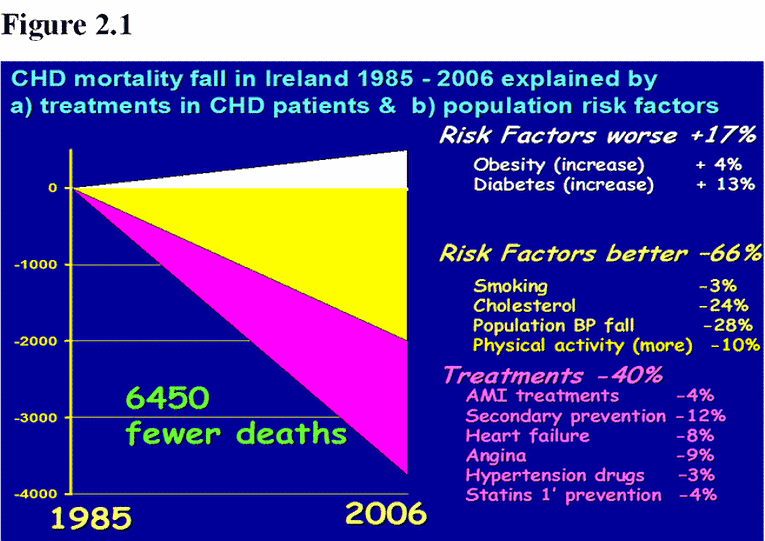Report by Dr Angie Brown and Dr Siobhan Jennings
National CVD Prevention Coordinators for Ireland:
 Angie Brown
Angie Brown
MD, FRCPI, MRCP, BSC, MB, Bchir
Consultant Cardiologist and Medical Director of the Irish Heart Foundation
email
 Siobhan Jennings
Siobhan Jennings
MB, DCH, MPH, FFPHMI
Consultant Public Health Medicine
email
Health care | Risk factors | Prevention methods | Prevention activities | Cardiac Rehab. | Future
Documents to download
Health care
Ireland has a multi-tiered health system which is undergoing major reform. Key elements of the reforms include the introduction of Universal Health Insurance and a focus on keeping people well and preventing ill health (Healthy Ireland). The Health Service Executive provides all of Ireland’s public health services. Approximately 80% of health funding is provided though the taxation system and private health insurance provides an additional source of funding.
40% of citizens are eligible for medical cards allowing access to a range of health services free of charge with the remainder having limited eligibility to free services. Further, 45.8% of citizens obtain private health insurance.
Ireland has 48 acute publicly funded hospitals, 28 have facilities for acute cardiac care and 9 of which are major cardiac centres with catheterisation suites. A further 7 private hospitals have cardiology services.
Reference: Catheterisation suites (7 centres are designated 24/7 primary percutaneous coronary intervention [PPCI] centres)
Risk factors
CHD mortality rates in Ireland fell by 68% in men and by 69% in women between 1985-2006. Approximately 40% (38% M; 45% F) of the CHD mortality decline could be attributed to improvements in treatment uptake. Approximately 48% (54% M; 37% F) was attributable to risk factor improvements.
Currently, smoking prevalence is estimated at 22%, three quarters of the population have cholesterol levels above recommended and over half have raised blood pressure (treated or untreated). At least six out of ten Irish adults (61%-64%) are overweight or obese and almost one in three Irish adults do not achieve a baseline level of recommended activity. Diabetes is increasing with prevalence estimated at 3.5% but projected to increase to 5.5%. Alcohol consumption is high at 11.9 litres per person per year.
Source: Kabir Z, et al, Modelling Coronary Heart Disease Mortality declines in the Republic of Ireland, 1985–2006, Int J Cardiol (2013),
Main actors & prevention methods
The National Cardiovascular Health Policy 2010-2019 identifies key players including:
-
The Department of Health
-
Health Service Executive
-
Health Information and Quality Authority
-
Irish Heart Foundation
-
Irish Cardiac Society
-
Irish Association for Cardiac Rehabilitation
-
Irish College of General Practitioners
-
Royal College of Physicians of Ireland
Prevention activities
Following earlier health promotion strategies specific initiatives addressing CVD in Ireland started in 1999 with “Building Healthier Hearts”, followed more recently by “Changing Cardiovascular Health: National Cardiovascular Health Policy 2010-2019”. The latest Government framework for action “Healthy Ireland”, launched in 2013, identifies the main population goals and approaches needed to create a healthier Ireland and strongly recommends inter-governmental and inter-sectoral action. Following a number of tobacco control initiatives including the workplace smoking ban in 2004 the Irish government has now set a target for "A Tobacco Free Society by 2025".
The Health Service Executive (HSE) funds all public sector health services including prevention campaigns such as the “QUIT campaign”; an integrated smoking cessation media campaign based on the statistic that 1 in 2 smokers will die of a tobacco-related disease, health promotion services based on the settings we live in, as well as contributing to policy development. Also, the HSE works in partnership with a number of agencies such as Safefood, an all-island body promoting awareness and knowledge of food safety and nutrition issues, which launched a Childhood Obesity Campaign in 2013.
There is a strong non governmental sector (NGO) sector focused on CVD prevention. The Irish Heart Foundation has health promotion programmes in the workplace, community and schools and has advocated on a number of issues including a tobacco free society and restrictions of marketing of foods high in fat, sugar and salt to children. CROí, based in the West of Ireland, has a number of programmes addressing high risk individuals e.g. “My Action” as well as a Masters and Postgraduate Diploma in Preventive Cardiology.
Cardiac Rehabilitation
Cardiac rehabilitation services in Ireland are provided in the cardiology departments of general hospitals. Virtually all such departments offer a programme. They are supervised by cardiologists and secondary prevention and rehabilitation are closely related.
In-patient cardiac rehabilitation never developed in Ireland. All rehabilitation is out-patient based and is provided by a multi-disciplinary team comprising, ideally, a physician, a nurse specialist, physiotherapist, dietician, social worker and in some cases a clinical psychologist. Structured advice on exercise with graduated circuit training, behavioural change, lifestyle and risk factor management is provided, backed up by videos and reading materials that are tested for appropriateness to the literacy of participants. Family participation is strongly encouraged.
The conventional three phases of cardiac rehabilitation are provided over 8 to 12 weeks. Attendance rates are generally high and the programmes are regarded as being supportive and are popular. Development of phase IV programmes is more variable although some programmes have developed strong community links. Rehabilitation was pioneered in three Dublin hospitals; more recently, the “My Action” programme in Galway in Western Ireland has been outstandingly successful.
The future
Ireland faces the challenge of an ageing population with predicted increase in hypertension, atrial fibrillation and obesity. The Government’s commitment to “increase the proportion of people who are healthy at all stages of life” is set out in the “Healthy Ireland” framework.
It is Government policy to be tobacco free by 2025 (smoking rate of less than 5%) and Ireland is set to become the first country in the EU to introduce standardised packaging of tobacco products.
The content of this article reflects the personal opinion of the author/s and is not necessarily the official position of the European Society of Cardiology

 Our mission: To reduce the burden of cardiovascular disease.
Our mission: To reduce the burden of cardiovascular disease.